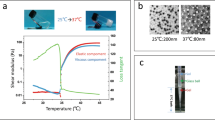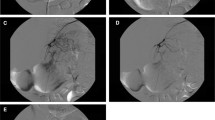Abstract
This research aimed to investigate the efficacy of trans-catheter left gastric artery embolization (LGAE) in the treatment of obesity with type 2 diabetes mellitus (T2DM), and to compare the advantages of thermo-sensitive nano-gel as a vascular embolization agent. In this study, nine healthy adult male beagle dogs were randomly divided into three groups (three dogs in each group) to establish the model of obesity with type 2 diabetes mellitus: a was the general embolization group of type 2 diabetes mellitus, and the embolization group of polyvinyl alcohol drug granules (PVA) by transcatheter left gastric artery embolization; In group B, the embolic agent was replaced by (N- isopropylacrylamide -co- butyl methacrylate) (PIB) temperature-sensitive nano-gel. Group C and the control group were perfused with 12 mL normal saline in the left gastric artery via catheter. The results showed that when the reaction temperature of PIB nanogel was between 60 ℃ and 80 ℃, the particle size fluctuated between (200.59 ± 2.78) and (213.31 ± 1.09) nm, and the phase transition temperature was between 30.1 ℃ and 31.0 ℃. Serum insulin concentration in PIB nanogel group was (19.55 ± 0.2274)uLU/mL lower than that in PVA group (20.89 ± 0.1144)uLU/mL (P < 0.05) and higher than that in the control group (17.72 ± 0.1298)uLU/mL (P < 0.05). The insulin resistance index of the PIB nanogel group (7.260 ± 0.13) was lower than that of PVA group (12.57 ± 0.25) (P < 0.05) and higher than that of the control group (5.015 ± 0.17) (P < 0.05). In conclusion, the thermo-sensitive nano-gel was used as a new vessel embolization agent, and the application of left gastric artery embolization for Beagle dogs with T2DM was beneficial to lower blood sugar, improve insulin resistance, and regulate insulin levels.











Similar content being viewed by others
References
Al-Sulaiti H, Diboun I, Agha MV, Mohamed FFS, Atkin S, Dömling AS, Elrayess MA, Mazloum NA (2019) Metabolic signature of obesity-associated insulin resistance and type 2 diabetes. J Transl Med 17(1):348
Bai ZB, Qin YL, Deng G, Zhao GF, Zhong BY, Teng GJ (2018) Bariatric embolization of the left gastric arteries for the treatment of obesity: 9-month data in 5 patients. Obes Surg 28(4):907–915. https://doi.org/10.1007/s11695-017-2979-9 (PMID: 29063494)
Chrysant SG, Chrysant GS (2019) Obesity-related heart failure with preserved ejection fraction: new treatment strategies. Hosp Pract 47(2):67–72. https://doi.org/10.1080/21548331.2019.1575662
Li L, Fu L, Ai X, Zhang J, Zhou J (2017) Design and fabrication of temperature-sensitive nanogels with controlled drug release properties for enhanced photothermal sterilization. Chemistry 23(72):18180–18186. https://doi.org/10.1002/chem.201702796 (Epub 2017 Sep 27 PMID: 28809441)
Meijnikman AS, Gerdes VE, Nieuwdorp M, Herrema H (2018) Evaluating causality of gut microbiota in obesity and diabetes in humans. Endocr Rev 39(2):133–153. https://doi.org/10.1210/er.2017-00192 (PMID: 29309555)
Paccosi S, Cresci B, Pala L, Rotella CM, Parenti A (2020) Obesity therapy: how and why? Curr Med Chem 27(2):174–186. https://doi.org/10.2174/0929867326666190124121725 (PMID: 30678612)
Pouwels S, Buise MP, Twardowski P, Stepaniak PS, Proczko M (2019) Obesity surgery and anesthesiology risks: a review of key concepts and related physiology. Obes Surg 29(8):2670–2677. https://doi.org/10.1007/s11695-019-03952-y (PMID: 31127496)
Rangel-Huerta OD, Pastor-Villaescusa B, Gil A (2019) Are we close to defining a metabolomic signature of human obesity? A systematic review of metabolomics studies. Metabolomics 15(6):93. https://doi.org/10.1007/s11306-019-1553-y.PMID:31197497;PMCID:PMC6565659
Rao M, Gao C, Xu L, Jiang L, Zhu J, Chen G, Law BYK, Xu Y (2019) Effect of inulin-type carbohydrates on insulin resistance in patients with type 2 diabetes and obesity: a systematic review and meta-analysis. J Diabetes Res 27(2019):5101423
Shih DP, Lin PY, Liang WM, Tseng PC, Kuo HW, Wang JY (2020) Sleep duration and effort-reward imbalance (ERI) associated with obesity and type II diabetes mellitus (T2DM) among Taiwanese middle-aged public servants. Int J Environ Res Public Health 17(18):6577
Singh A, Vaishagya K, Verma K, R, Shukla R, (2019) Temperature/pH-triggered PNIPAM-based smart nanogel system loaded with anastrozole delivery for application in cancer chemotherapy. AAPS PharmSciTech 20(5):213. https://doi.org/10.1208/s12249-019-1410-3
Takahashi EA, Takahashi N, Reisenauer CJ, Moynagh MR, Misra S (2019) Body composition changes after left gastric artery embolization in overweight and obese individuals. Abdom Radiol (NY) 44(7):2627–2631
Volaco A, Cavalcanti AM, Filho RP, Précoma DB (2018) Socioeconomic status: the missing link between obesity and diabetes mellitus? Curr Diabetes Rev 14(4):321–326. https://doi.org/10.2174/1573399813666170621123227 (PMID: 28637406)
Walsh JS, Vilaca T (2017) Obesity, type 2 diabetes and bone in adults. Calcif Tissue Int 100(5):528–535. https://doi.org/10.1007/s00223-016-0229-0
Xu HL, Xu J, Zhang SS, Zhu QY, Jin BH, ZhuGe DL, Shen BX, Wu XQ, Xiao J, Zhao YZ (2017) Temperature-sensitive heparin-modified poloxamer hydrogel with affinity to KGF facilitate the morphologic and functional recovery of the injured rat uterus. Drug Deliv 24(1):867–881. https://doi.org/10.1080/10717544.2017.1333173 (PMID: 28574291)
Zaitoun MMA, Basha MAA, Hassan F, Elsayed SB, Farag AA, Amer M, Aly SA, Zaitoun N (2019) Left gastric artery embolization in obese, prediabetic patients: a pilot study. J Vasc Interv Radiol 30(6):790–796. https://doi.org/10.1016/j.jvir.2019.02.010 (Epub 2019 Apr 27 PMID: 31040059)
Zhou C, Shi Q, Liu J, Huang S, Yang C, Xiong B (2020) Effect of inhibiting tumor angiogenesis after embolization in the treatment of HCC with apatinib-loaded p(n-isopropyl-acrylamide-co-butyl methyl acrylate) temperature-sensitive nanogel. J Hepatocell Carcinoma 31(7):447–456
Acknowledgements
The Joint Fund of National Natural Science Foundation of China (No. U1603127).
Author information
Authors and Affiliations
Corresponding author
Ethics declarations
Conflict of interests
The authors declare that they have no competing interests.
Additional information
Publisher's Note
Springer Nature remains neutral with regard to jurisdictional claims in published maps and institutional affiliations.
Rights and permissions
Springer Nature or its licensor (e.g. a society or other partner) holds exclusive rights to this article under a publishing agreement with the author(s) or other rightsholder(s); author self-archiving of the accepted manuscript version of this article is solely governed by the terms of such publishing agreement and applicable law.
About this article
Cite this article
Cao, G., Gu, J., Zhang, H. et al. Treatment of obesity with type 2 diabetes mellitus by trans-catheter left gastric artery embolization under the thermo-sensitive nano-gel vascular embolization agent. Appl Nanosci 13, 3533–3541 (2023). https://doi.org/10.1007/s13204-022-02697-y
Received:
Accepted:
Published:
Issue Date:
DOI: https://doi.org/10.1007/s13204-022-02697-y




